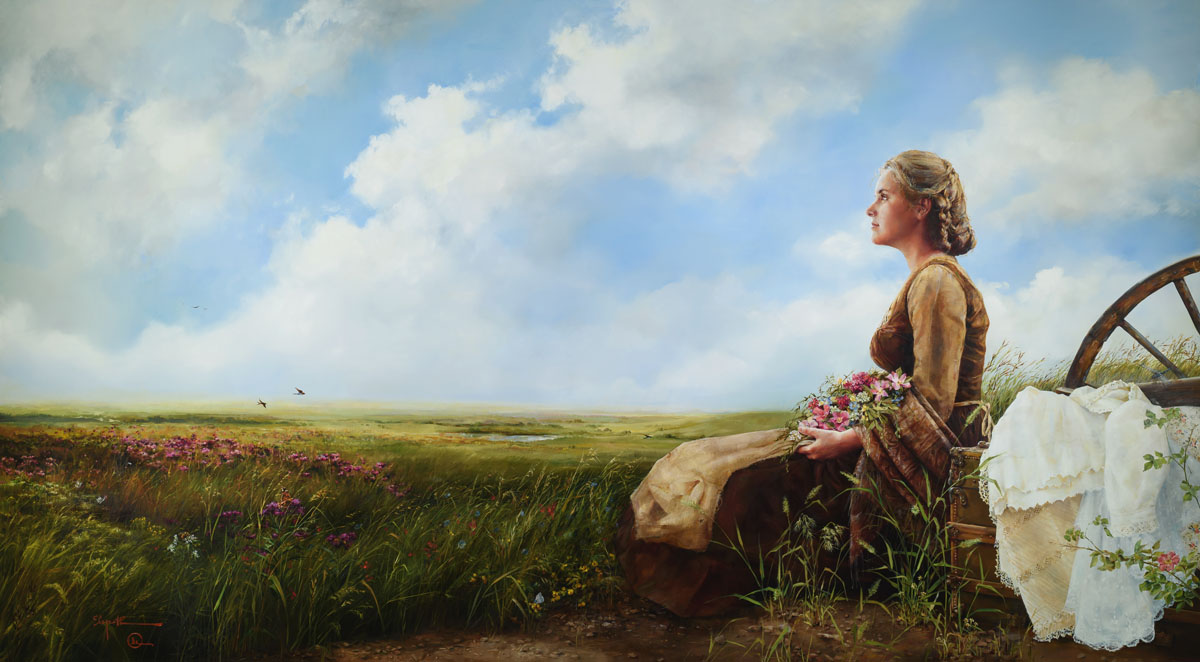Saving thousands of brushstrokes
By Elspeth C. Young
If God So Clothe The Field (Margaretta Unwin Clark) was painted by the artist in the studios at Ben Haven.Dimensions (unframed width x height)
86 in. x 47 in.
Support
Panel
Milestones
Research commences - May 2016
Painting commences - August 2016
Painting completed - March 2016
Equipment
Creating a painting often involves creating or modifying tools or making improvements to the studio itself. This painting project necessitated the following activities in terms of tools, supplies, and operations.
Creating a plein air studio
Costumes, miniatures, and props
Sometimes these items must be created at the Studios, sometimes they are purchased for the project, and sometimes items created or purchased for other projects are re-used or modified. This section does not list every costume element, miniature, or prop that may have been involved in the project. Instead, we include items whose story might prove interesting or useful.
Methodology
This section presents only one or two items that may be of interest to professional artists, amateurs, and others interested in the work of the Studios.
These excerpts from Elspeth's Painting Diary during the creation of this painting provide a glimpse of the nature of this project:
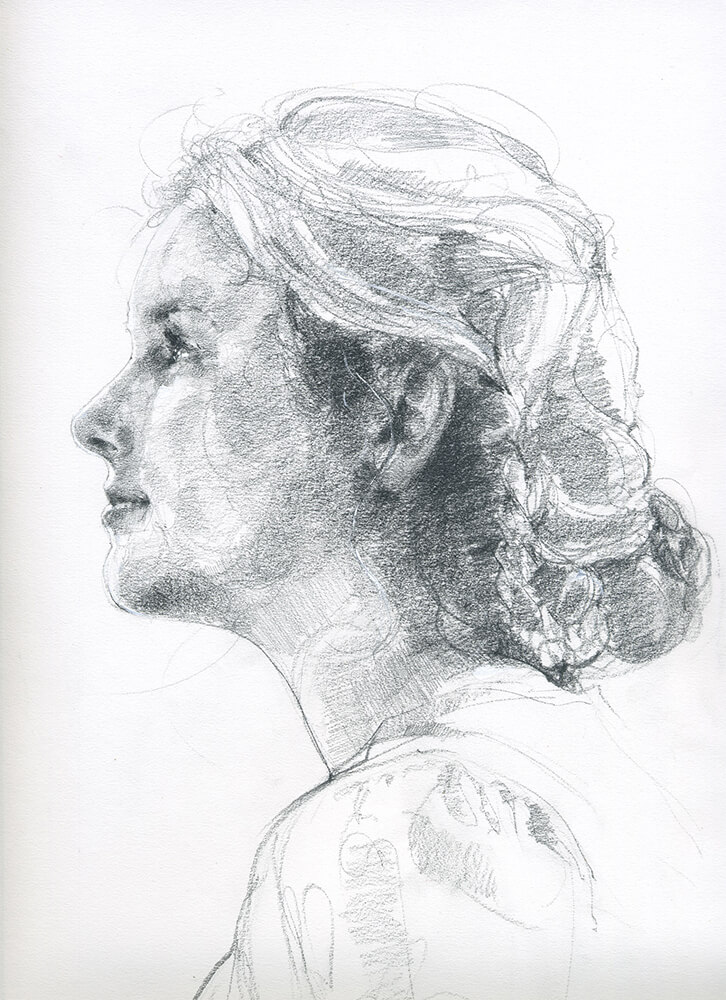 |
| Pencil study of model for Margerette Clarke by Elspeth Young |
March and April 2017
I'm thinking of changing my mind, and placing Margaretta in Iowa, not Wyoming. Easier to express the beginning of the trek, not the weary, starving latter end.
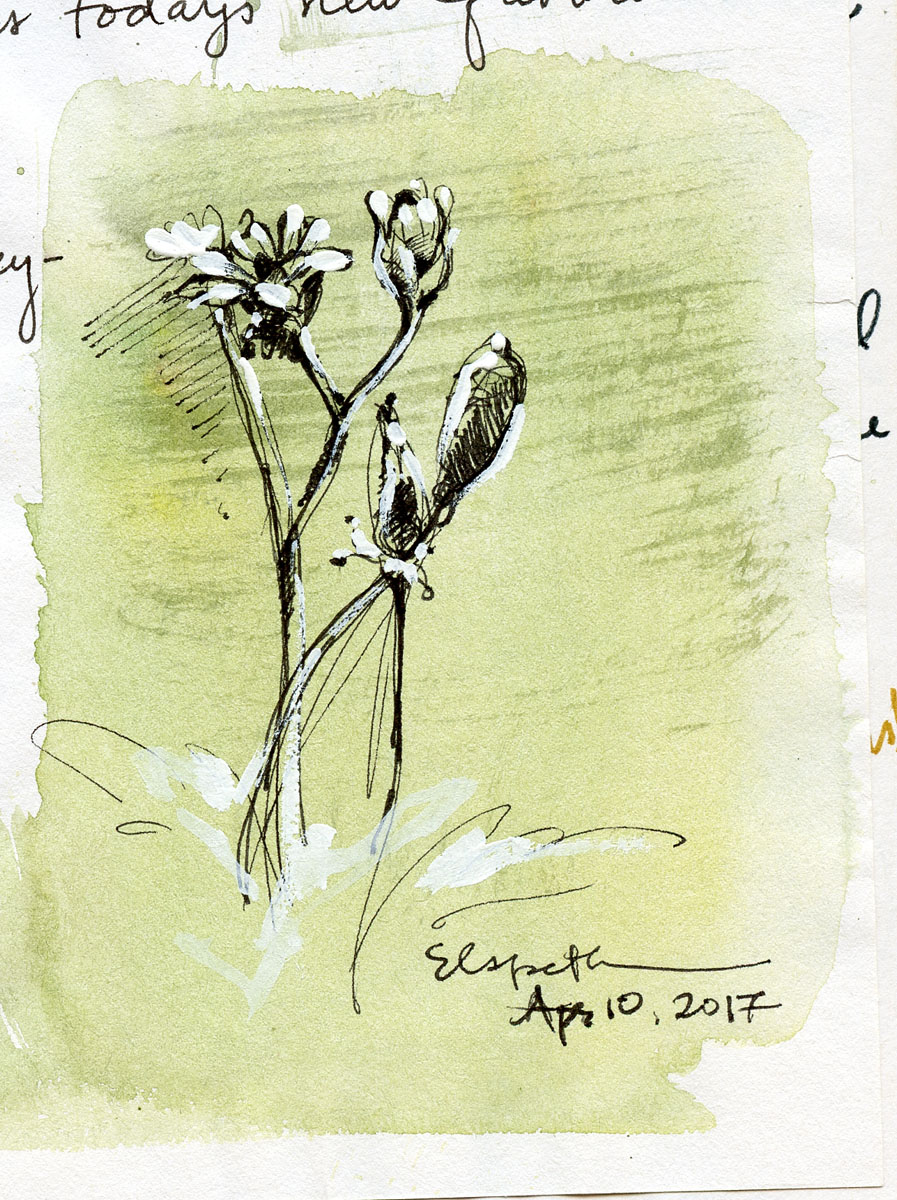 |
| Flora study in pen, ink , gouache and watercolor by Elspeth Young |
I am knee-deep in 1600 pages of 19th and early 20th century Iowa flora and weeds, hunting Margaretta specimens. Whitlow grass is today's new favorite. I also picked my sweeping, dramatic sky of choice while watching an early morning sky-epic unfold on the south side of our home. This is going to be another build-your-ownpainted-prairie-adventure like I painted in my original painting of Lucinda Gibson Strickland Pace.
I had some extra shelf-stretched canvas sitting around with an unwanted painting I created in 2004. I decided to paint over it with a painted sketch of the sky-scape composition for Margaretta. It worked a treat. Immediately, difficulties came to light, and it enabled me to sketch from life. I have worked at approximately 1/5th actual size of the 48 by 86 inch finished painting. This is a wonderful way to plan. It is free and emotive, and—since every inch represents at least five inches—saves no end of trouble later. (One brush stroke fixed now will save hundreds, maybe even thousands, more later, if I paint out a redesign where needed now.)
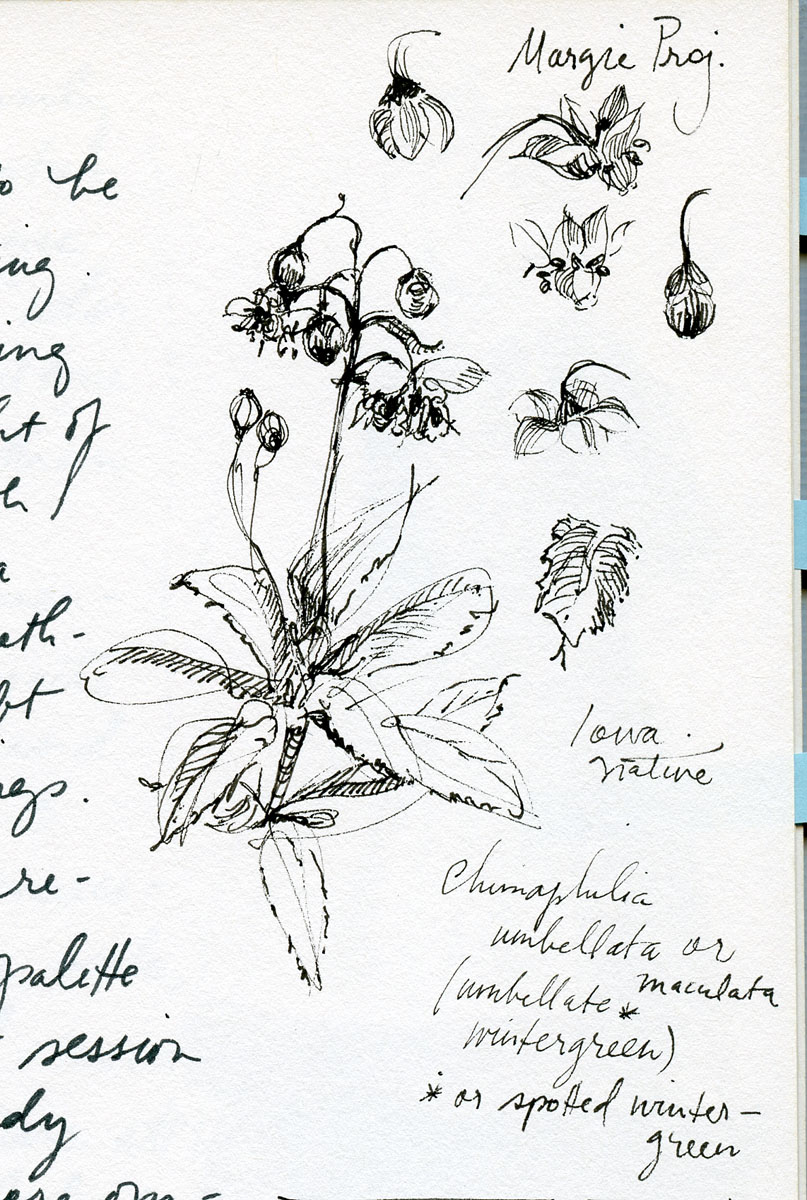 |
| Flora study in pen and ink by Elspeth Young |
It also gives me an easy way to study a very large composition all at one glance, as it will be seen hanging in the setting for which the painting is destined.
May 2017
Saturday saw several firsts as I was installed in the plein air studio in Freckles Room, ready to begin a 48-inch x 86-inch painting. My first that large; my first day wearing newly-acquired Chef's apparel for messy outdoor mural work—a white hat with ties in the back, plus a bistro divided-pocket apron; and my absolutely first day painting with oil paints applied with a lambswool roller. I would never have included a roller in my brush repertoire, but for Kurt Welte's compendium on painting—my personal Art Bible—which suggested such for early applications. It was tremendously helpful to save damage to my neck and wrist while laying down my first layer of blue. Now that this layer is dry, I am going over all the clouds, originally a zinc and titanium white combination, using a sort of watercolor-meets-oil technique I developed while working on my painting, The Pure in Heart. I also have a new book, for researching Margaretta, called Restoring the Tallgrass Prairie by Shelia, copyright 1994.
Having worked this week on the ginormous sky in the Margaretta painting, I'm beginning to see that, when painting and storing a mural in an outdoor Studio, less is more. More paint sessions of briefer duration is a safer investment of time than long ones. Less risk to glaze layers and fresh paint, and less physical wear and tear on me, sore feet and wrist muscles are guaranteed.
I'm not sure I can describe the pleasure of painting plein air in my very own Studio. This studio abuts our woodworking shop and the outdoor covered work area for Ashton, mainly to create casts for hand carved frames. I am glassed-in on the North, and open to roses and an inner fence on the East. My regular visitors currently are hummingbirds, quail, and every flying insect known to Utah Valley.
I believe it is the influence of painting so many happy hours outdoors which enabled an epiphany today. I am continuing my third week painting the Margaretta prairie sky and today was the first day I felt SKY. I can paint a sky pretty convincingly if you put a misty sky in front of me, but the kind of glorious, puffy clouds and spectacular blues for which Dad's sky paintings are famous, have eluded me all these years. But today I finally got SKY in my blood and painted until my hand and wrist were exhausted. I imbibe from the glories outside my plein air studio's view and then paint what I feel inside. This is a red-letter day!
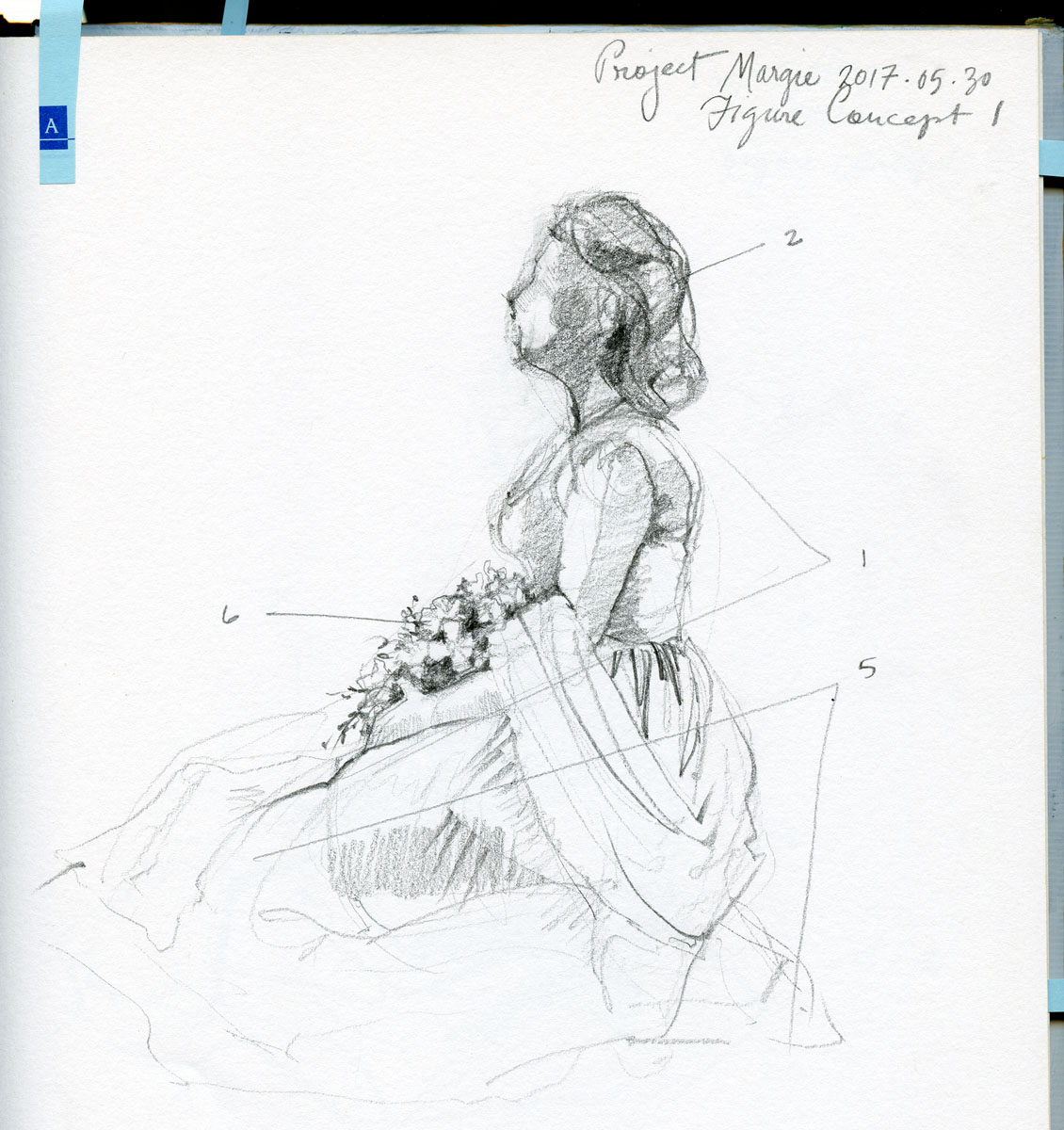 |
| Figure study in pencil by Elspeth Young |
Today, Mom and I strolled among the grasses, mallow, sleeping, and sweet clover beneath Traverse Mountain, imbibing prairie spirit. As the sound of a meadow lark reached our delighted ears, my mother said of Margaretta: You'll have to paint the sound of a meadowlark! Such will be my goal.
Saturday, Dad and I painted side-by-side on my painting of Margaretta. My shoulder is inhibiting large brush strokes such as are needed for the mega-sized sky; besides, I felt impressed that Dad's incredible and unparalleled expressive sky-painting visions are needed for this show-stopper painting. So, using my previously painted sky as a compositional map and underpainting, he gave my sky an extreme makeover. Afterwards, I coaxed out highlights and patches of sky where I felt it necessary, and we had a splendid time.
June 2017
I am in my plein-air studio, creating prairie. I'm not sure how many artists paint amidst the fall of white rose petals or the punctuation of bird song, but I do, thanks to wonder-carpenters Dad and Ashton. I am, however, finding each day an adventure of discovery. Spider mites crawl up my arms and bite once temperatures exceed 68 degrees, and one wind gust can fill my painting palette with dust and debris. So far my painting has attracted and killed at least 22 insects.
But each day I get the hang of it. Today was wet-in-wet impressionist technique to begin to begin the painting of patches of Joe-pye-weed. A very good day. To paint a prairie has expanded my usual paint palette.
We moved Margaretta inside to the loft easel upstairs, yesterday, so that I can beat the 100 degree weather.
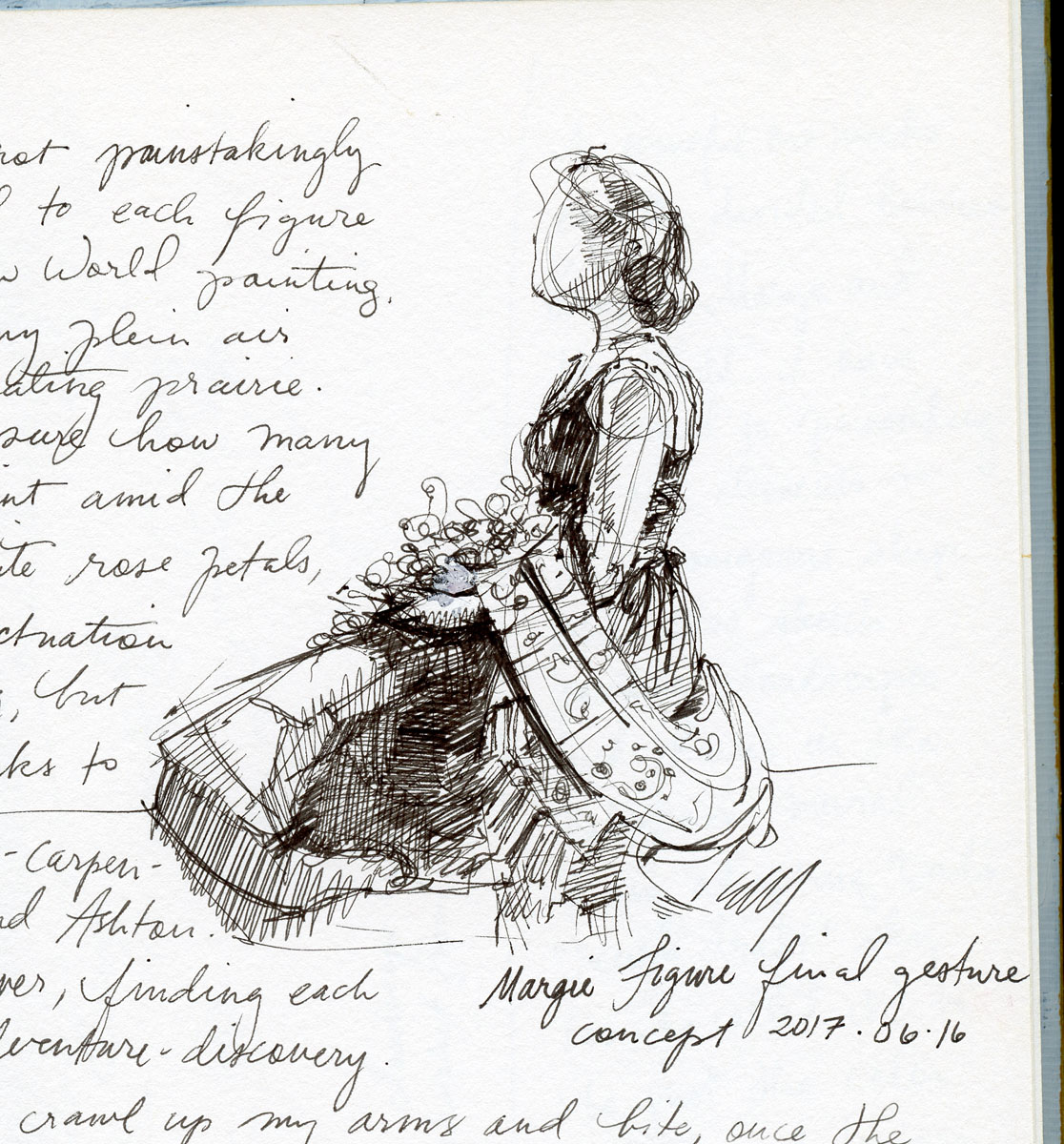 |
| Costume study in pen and ink by Elspeth Young |
July 2017
The children of our patron chose, from my highly researched plant list, the specimens of Margaretta's bouquet, plus the prairie insects to be painted in this painting: Butterflies, for example, will be American painted lady, spring azure, silvery-blue, and cabbage white. The insects will be a rusty patched bumblebee and slaty skimmer. The bouquet will include Partridge pea, common mountain mint, Joe-pye-weed, ironweed, prairie rose, and swamp milkweed.
At long last the sort of prairie quilt I was painting is being transformed into a real-life prairie in appearance and mood. I'm so accustomed to painting vertical paintings that a 7 by 4 foot horizontal landscape has proven to be a much more formidable creative mess than I had supposed. Instead of painting a series of layers top to bottom, I have to paint from the back of the painting towards the viewer in every direction. It takes tremendous planning! Even 13 months of previous planning have hardly scratched the surface. But at last, by following Nephi's creative pattern in 1 Nephi 18 (at Mom's inspired suggestion), I am doing much better and the poetry of Margaretta's surroundings is emerging.
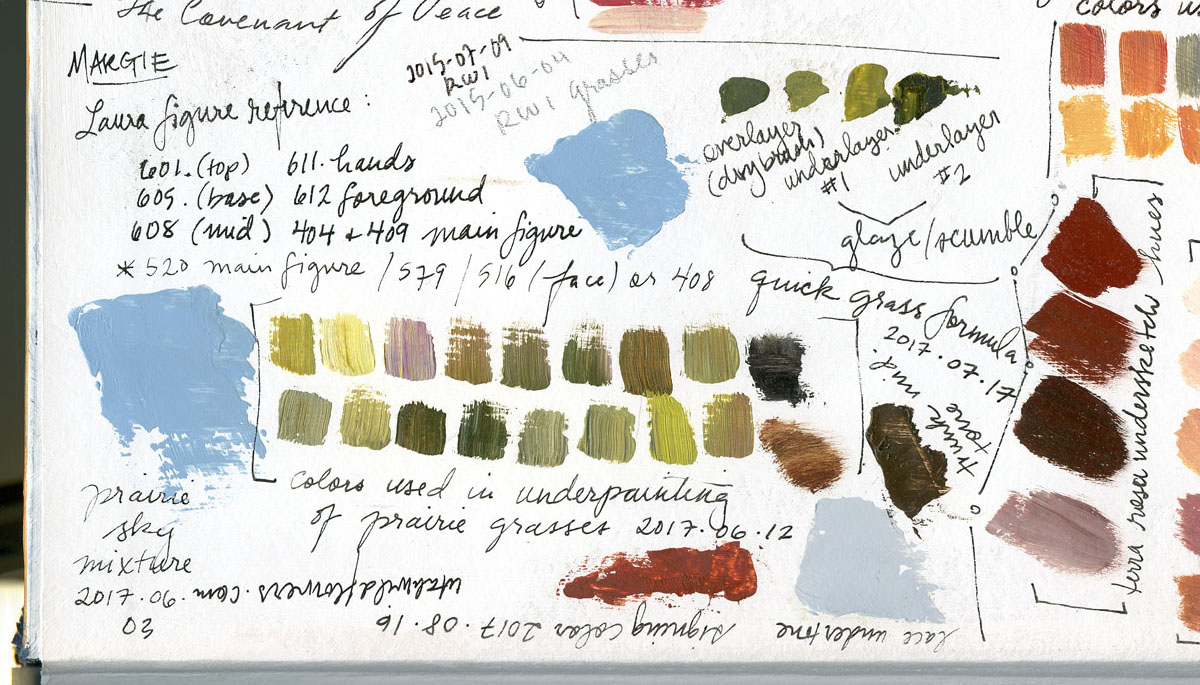 |
| Prairie color-swatch study in watercolor by Elspeth Young |
Right now I'm up to my elbows in grass research. I've already painted wild bluestem behind where the handcart will be painted, and will be painting Indian grass, wild oats, witchgrass, dusty brome, and panic grass in the mid and foreground areas. Today, while out for a nature walk for a much-needed infusion of inspiration, I also realized that dead seed heads of thistles and such is a glaring omission in my prairie! I'll be adding those, too.
All my waking hours are obsessed with completing the Margaretta painting! At last I am grateful to say the year of careful thinking, praying, and planning is paying off.
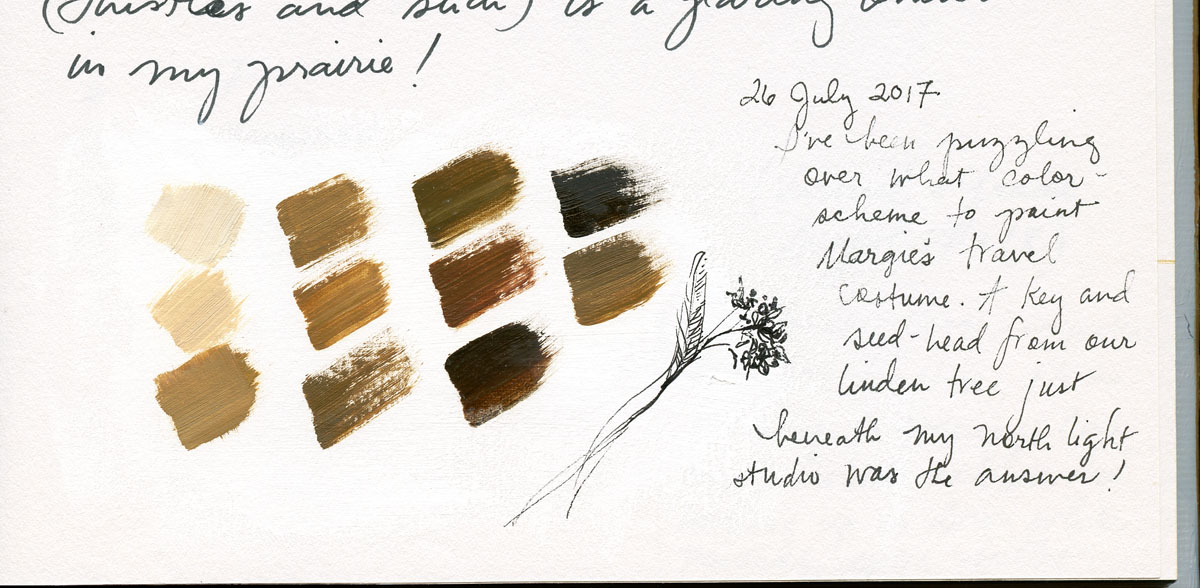 |
| Costume color-swatch study in watercolor by Elspeth Young |
The Prairie-scape is in its 23rd layer. I paint detailed grasses wet-in-wet, allow to dry, deeply glaze the shadows while also adding dry-brush and scumble highlights, and begin the cycle again—as I move down the panel from the horizon line.
Today was my third layer on the authentic handcart I'm painting. There are only two extant Mormon handcarts, scholar Melvin Bashore assures me. One is held at the Church History Museum in Salt Lake City, the other is at the Smithsonian. I'm painting the Church-owned antique, and loving the experience of translating it into painting-ese.
Two walks today, book-ending my painting day, to get more prairie in my soul. On an early morning stroll I imbibed grasses, thistles, wild roses, and soft light, deciding to add an awning band of rosa Arkansana to the lower right corner of Margaretta, plus the free flowing martins and swifts planned for the left of the composition. In the sweet light of early evening, I saw a damselfly in the exact color of Margie's costume. Such a glory of siena and ochre must also be added!
August 2017
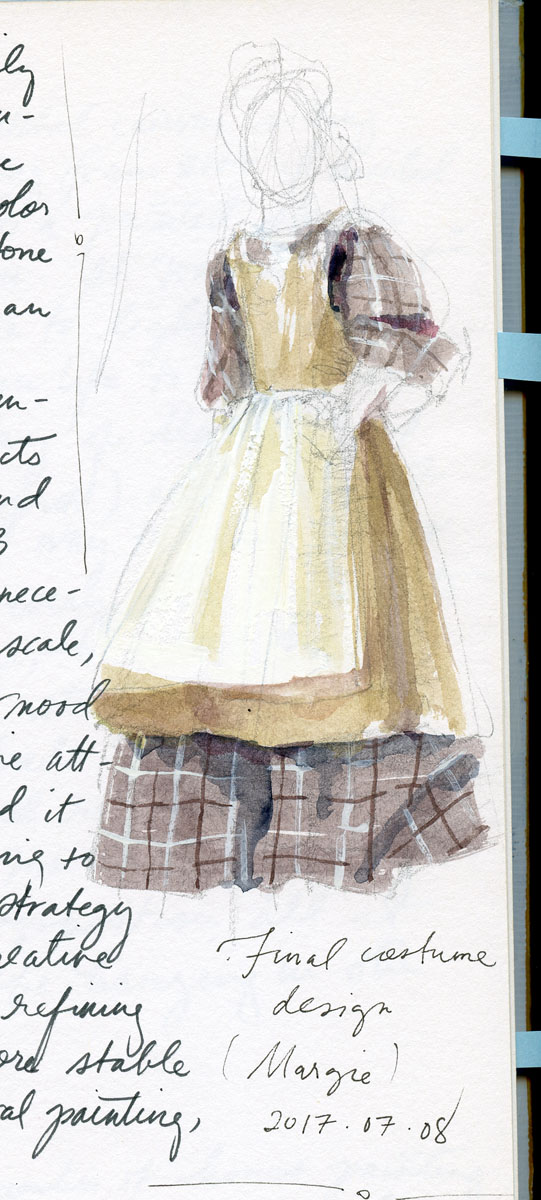 |
| Costume element color study in gouache by Elspeth Young |
I'm never happy painting flora from pictures. Too stale. So, as always, I find the specimen, or closest approximation to hand, and tape it to my painting so I can paint from life. I also currently have an arrangement of grasses secured in sand, by which to observe the prairie. So, on my fourth layer of Margaretta's bouquet, I have scabiosa, flax, and Jupiter's beard, plus single-flowering rose, to stand-in for common mountain mint, flax, swamp milkweed, and wild rose. All of these are the choices plus ironweed and Joe pye-weed, of the children. Painting from life adds vitality to my brush and a song in my heart.
I am also painting, from life, quite a growing number of insect specimens. Butterfly wings, dragonflies, and bumble bees are also near my easel, lending inspiration.
Everything is taking longer than hoped or expected, but turning out better. The prairie is in its 27th layer. Mom calls it the Calico Prairie because the distribution of flowers reminds her of the 19th century fabric pattern, dotted with brightly colored blossoms. Highly appropriate, considering the painting's theme and story!
I am discouraged however. My iron oxide underlayer for the figure is hindering my ability to varnish the painting. I have discovered that I can only use synthetic terra rosa without medium. Any medium or drying agent present makes the painting's surface like glass. It is difficult to paint on top of that. Ah well.
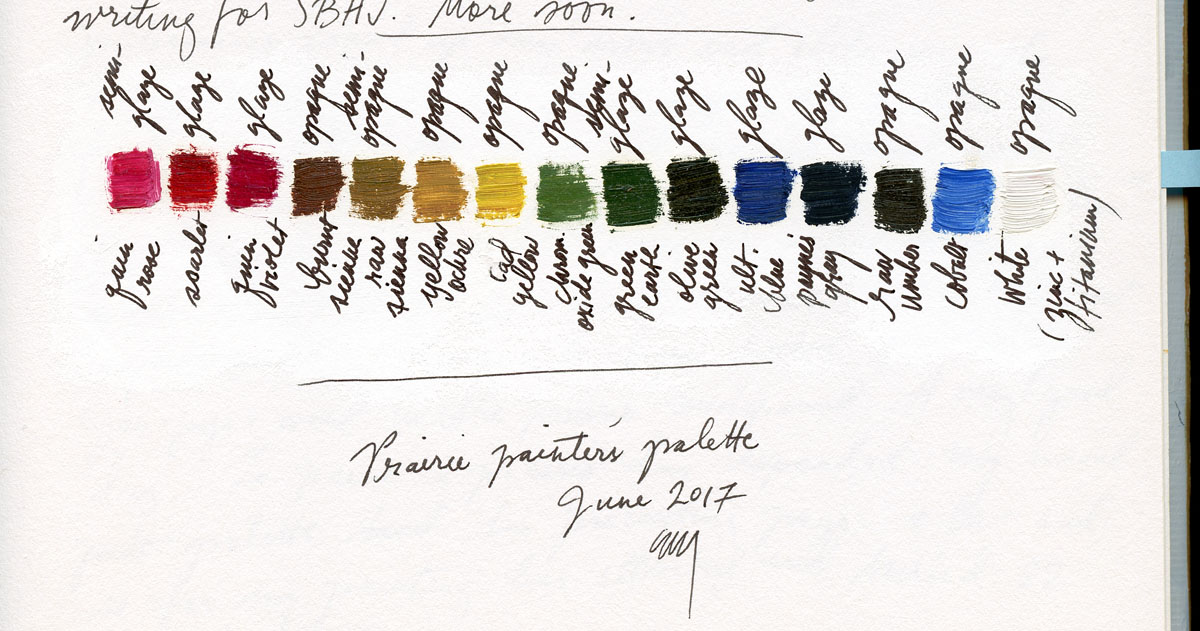 |
| Record of the oil pigment palette for the entire painting |
I don't believe in favorite paintings, but I do believe in favorite bits in paintings. My favorite bit in Margaretta are the tiny white grasses growing, weed like, among the foxtail grasses beneath Margie's trunk. They express my feeling that God adds his own lace to the field by means of such low-growing weeds—blessings and tender mercies—which we may unwittingly tread underfoot, but are there all the same. Only goodness gives extras, as Arthur Conan Doyle would say.
Tags: If God So Clothe The Field, 2018, Project commentaries
Browse articles by year: 2025 . 2024 . 2023 . 2022 . 2021 . 2020 . 2019 . 2018 . 2017 . 2016 . 2015 . 2014 . 2013 . 2012 . 2011 . 2010 . 2009 . 2008 . 2007 . 2006 . 2005 . 2004 . 2003 . 2002 . 2001 . 2000 . 1999 . 1998 . 1997 . 1996
Browse articles by topic: Art lessons . BenHaven Archives . Blank art diaries . Fine art photography . Framing . Illustration . Inspiration and creativity . Isles of Rune . Limited Editions Collection . My Fathers Captivity . News . Novellas . Oil paintings and prints . Operations announcements . Orders and shipping . Overview . Portfolios . The Papers of Seymore Wainscott . Project commentaries . Recipes by Nancy Young . Recommended reading . Recommended viewing . Temple artworks . The Storybook Home Journal . Tips and techniques . Tools supplies and operations
Browse articles by topic: Art lessons . BenHaven Archives . Blank art diaries . Fine art photography . Framing . Illustration . Inspiration and creativity . Isles of Rune . Limited Editions Collection . My Fathers Captivity . News . Novellas . Oil paintings and prints . Operations announcements . Orders and shipping . Overview . Portfolios . The Papers of Seymore Wainscott . Project commentaries . Recipes by Nancy Young . Recommended reading . Recommended viewing . Temple artworks . The Storybook Home Journal . Tips and techniques . Tools supplies and operations
